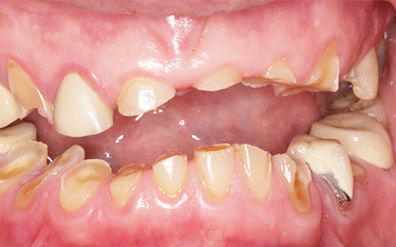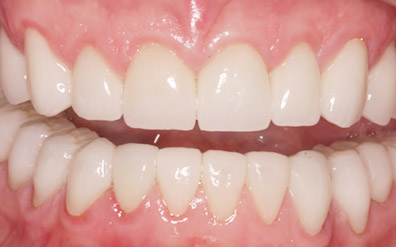Visit Our Office 155 W. 68th Street #228
New York, NY 10023
Call or Text
212.724.6280
Gum Grafting
What is a Gum Graft?
A gum graft is a mucogingival surgery designed to correct the condition of receding gums due to periodontal disease. Gum grafting or ‘Periodontal plastic surgery’ can be performed on gums that have receded to improve the appearance of a smile and also to protect your teeth against the biological and functional effects of gum recession.
What is Gum Recession?
Gum recession is the exposure of the root surface due to the loss of the soft tissue around the neck of your tooth. Normally, healthy gums are tightly bound around teeth, helping to protect them while also creating an attractive smile. Receding gums result in the tooth looking longer due to the roots being exposed. This can cause functional problems to the tooth while causing unacceptable soft tissue esthetics. As the tooth roots are exposed, they may feel more sensitive to hot and cold while also becoming more susceptible to decay. Unfortunately, due to the gradual process of gum disease and recession, many people don’t realize that the gums have receded.
It is important to treat significant gum recession, otherwise, it could ultimately lead to tooth loss or increased tooth sensitivity. The gum graft surgery we perform in our Manhattan NYC office can help restore the lost gum tissue and decrease tooth sensitivity.
Why Does Gum Recession Happen?
Most causative factors for gum recession share 1) gingival inflammation as one common feature. Other factors that can predispose an area to gingival recession can be 2) the lack of thickness and type of the gum tissues surrounding the root, 3) presence of thin bony plate or its absence surrounding the root, 4) root prominence, 5) tooth malalignment, 6) lack of vestibular depth with high frenum attachments and 7) trauma and plaque accumulation from restorative margins
Types of Gum Graft Surgery in NYC
What should you expect from gum graft surgery? First, your gums will need to be properly evaluated by a periodontist. If you have signs of gingival inflammation or active gum disease, you will require treatment to restore gum health prior to NYC gum graft surgery. Generally, the more severe the damage from gum recession, the less predictable it is to get complete root coverage after gum graft surgery. There are several different types of gum grafts, depending on your specific needs. Your options include:
Chao Pin Hole Technique
The Pin-hole technique is a minimally invasive, fast and effective treatment option especially for those suffering from generalized gum recession. Pin-hole surgical procedure NYC allows Dr. Kong to reposition your existing gum tissue through a couple of tiny pencil tip sized holes high up in your existing gum tissue. A special set of instruments are then used to loosen and stretch the gum tissue, allowing it to be gently pulled into place to cover your tooth roots. The benefits associated with this technique is that there is no scapels, stitches or donor tissue grafting.
Connective Tissue Graft
A subepithelial connective tissue graft is used to treat exposed tooth roots caused by gum recession. During this gum surgery procedure, a small pouch incision is made into the roof of your mouth, so the connective tissue layer underneath the top epithelial layer can be removed. This connective tissue is then transferred and secured in place around the exposed tooth
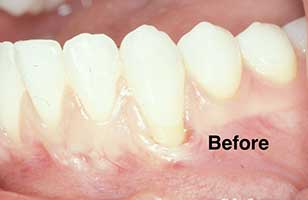
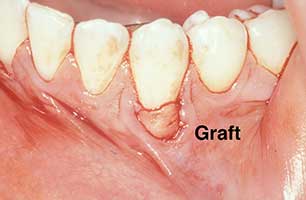
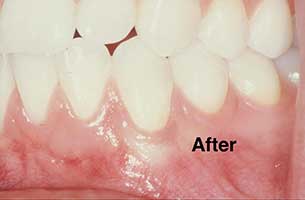
Free Gingival Graft
A free gingival graft is used in problem areas presenting with a lack of keratinized tissue and gingival recession. Free gingival grafts also use tissue from the roof of the mouth, however instead of creating a flap, a small piece of tissue is removed directly from the outer layer of the roof of the mouth (epithelium) and this used to cover up the exposed tooth area being treated. This gum surgery procedure might be recommended if your gum tissue is already quite thin, as the graft can help effectively create an adequate zone of attached gingiva and coverage of the exposed roots.
Pedicle Graft
Pedicle grafts are grafted from the soft tissues adjacent to the recession area and repositioned over the affected tooth. The soft tissue is partially incised so it remains attached at one edge and laterally rotated and secured over the receded root. This procedure is only possible for people who have a wide area of available gum tissue near the exposed tooth.
Does Gum Grafting hurt?
During the gum grafting surgery, your NYC periodontist will make sure you receive plenty of local anesthetics to make the procedure painless and will help to ensure that you feel comfortable. Following the gum graft surgery, the pain the patient feels will depend largely on the type of gum surgery performed. For a few days after the procedure, most patients compare the discomfort of having a pizza burn.
How Much Does Gum Graft Cost?
Gum grafting surgery cost varies largely depending on the type of gum surgery needed and the extent of gum recession.
Is Gum Grafting Covered by Insurance?
Patients with dental insurance may be able to get all or part of the gum graft surgery covered by their insurers. We can help you with the estimate specific to your plan or you can request an estimate from your insurance company to get an idea of the overall cost.


